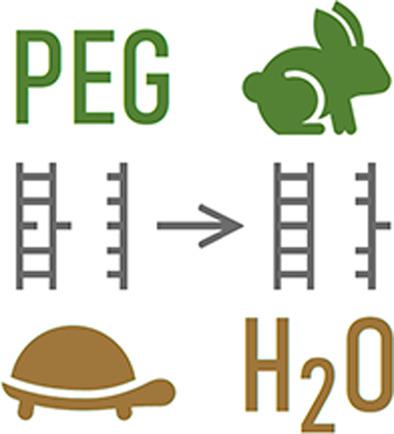当前位置:
X-MOL 学术
›
Biopolymers
›
论文详情
Our official English website, www.x-mol.net, welcomes your
feedback! (Note: you will need to create a separate account there.)
Mismatch detection in homologous strand exchange amplified by hydrophobic effects
Biopolymers ( IF 3.2 ) Pub Date : 2021-03-29 , DOI: 10.1002/bip.23426 Bengt Nordén 1 , Tom Brown 2 , Bobo Feng 1
Biopolymers ( IF 3.2 ) Pub Date : 2021-03-29 , DOI: 10.1002/bip.23426 Bengt Nordén 1 , Tom Brown 2 , Bobo Feng 1
Affiliation

|
In contrast to DNA replication and transcription where nucleotides are added and matched one by one, homologous recombination by DNA strand exchange tests whole sequences for complementarity, which requires elimination of mismatched yet thermodynamically stable intermediates. To understand the remarkable sequence specificity of homologous recombination, we have studied strand exchange between a 20‐mer duplex containing one single mismatch (placed at varied positions) with the matching single strand in presence of poly(ethylene glycol) representing a semi‐hydrophobic environment. A FRET‐based assay shows that rates and yields of strand exchange from mismatched to matched strands rapidly increase with semi‐hydrophobic co‐solute concentration, contrasting previously observed general strand exchange accelerating effect of ethyl glycol ethers. We argue that this effect is not caused simply by DNA melting or solvent‐induced changes of DNA conformation but is more complex involving several mechanisms. The catalytic effects, we propose, involve strand invasion facilitated by reduced duplex stability due to weakened base stacking (“longitudinal breathing”). Secondly, decreased water activity makes base‐pair hydrogen bonds stronger, increasing the relative energy penalty per mismatch. Finally, unstacked mismatched bases (gaps) are stabilized through partly intercalated hydrophobic co‐solvent molecules, assisting nucleation of strand invasion at the point of mismatch. We speculate that nature long ago discovered, and now exploits in various enzymes, that sequence recognition power of nucleic acids may be modulated in a hydrophobic environment.
中文翻译:

通过疏水效应放大同源链交换中的错配检测
与 DNA 复制和转录相比,核苷酸被一个一个地添加和匹配,DNA 链交换的同源重组测试整个序列的互补性,这需要消除错配但热力学稳定的中间体。为了理解同源重组的显着序列特异性,我们研究了包含一个单一错配(位于不同位置)的 20 聚体双链体与代表半疏水环境的聚(乙二醇)存在的匹配单链之间的链交换. 基于 FRET 的分析表明,从错配到匹配的链交换的速率和产率随着半疏水性共溶质浓度的增加而迅速增加,这与之前观察到的乙二醇醚的一般链交换加速作用形成对比。我们认为这种效应不仅仅是由 DNA 熔解或溶剂诱导的 DNA 构象变化引起的,而是更复杂的,涉及多种机制。我们提出,催化效应涉及由于碱基堆积减弱(“纵向呼吸”)而导致双链体稳定性降低而促进的链侵入。其次,降低的水活度使碱基对氢键更强,增加了每次错配的相对能量损失。最后,未堆叠的错配碱基(间隙)通过部分插入的疏水共溶剂分子稳定,在错配点协助链侵入成核。我们推测,大自然很久以前就发现,现在在各种酶中利用,核酸的序列识别能力可能在疏水环境中受到调节。
更新日期:2021-04-29
中文翻译:

通过疏水效应放大同源链交换中的错配检测
与 DNA 复制和转录相比,核苷酸被一个一个地添加和匹配,DNA 链交换的同源重组测试整个序列的互补性,这需要消除错配但热力学稳定的中间体。为了理解同源重组的显着序列特异性,我们研究了包含一个单一错配(位于不同位置)的 20 聚体双链体与代表半疏水环境的聚(乙二醇)存在的匹配单链之间的链交换. 基于 FRET 的分析表明,从错配到匹配的链交换的速率和产率随着半疏水性共溶质浓度的增加而迅速增加,这与之前观察到的乙二醇醚的一般链交换加速作用形成对比。我们认为这种效应不仅仅是由 DNA 熔解或溶剂诱导的 DNA 构象变化引起的,而是更复杂的,涉及多种机制。我们提出,催化效应涉及由于碱基堆积减弱(“纵向呼吸”)而导致双链体稳定性降低而促进的链侵入。其次,降低的水活度使碱基对氢键更强,增加了每次错配的相对能量损失。最后,未堆叠的错配碱基(间隙)通过部分插入的疏水共溶剂分子稳定,在错配点协助链侵入成核。我们推测,大自然很久以前就发现,现在在各种酶中利用,核酸的序列识别能力可能在疏水环境中受到调节。











































 京公网安备 11010802027423号
京公网安备 11010802027423号